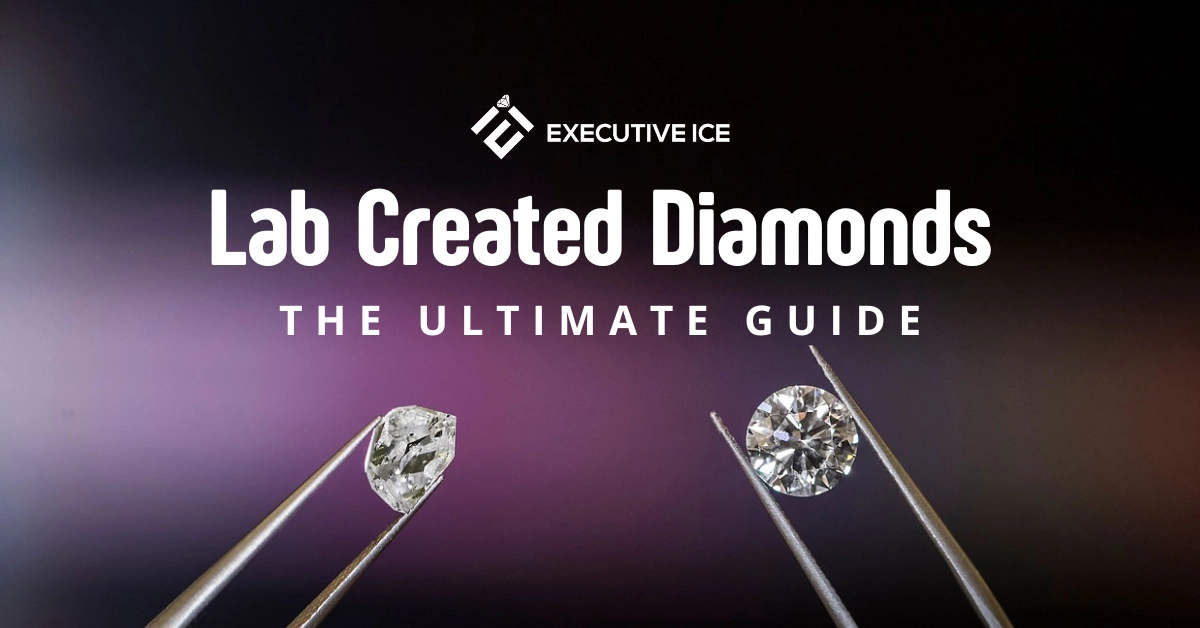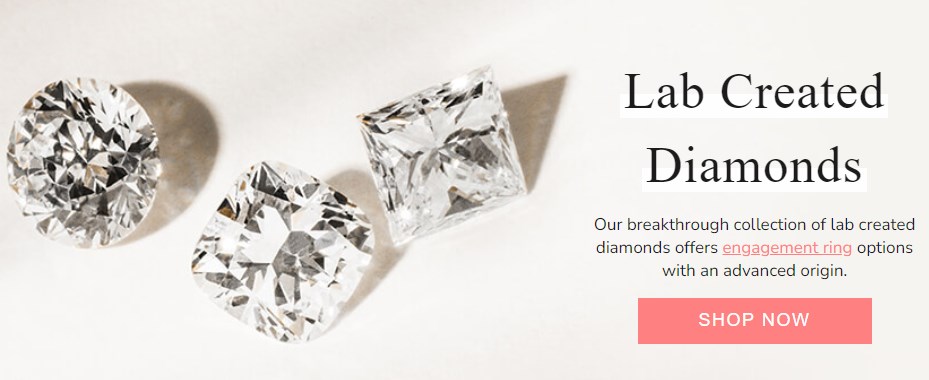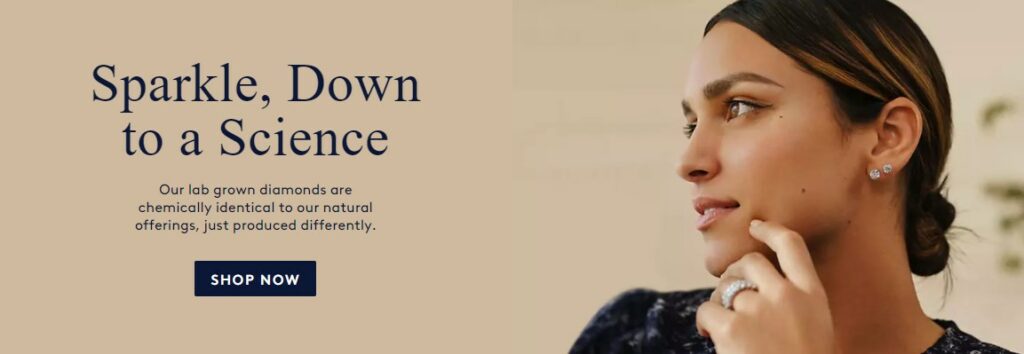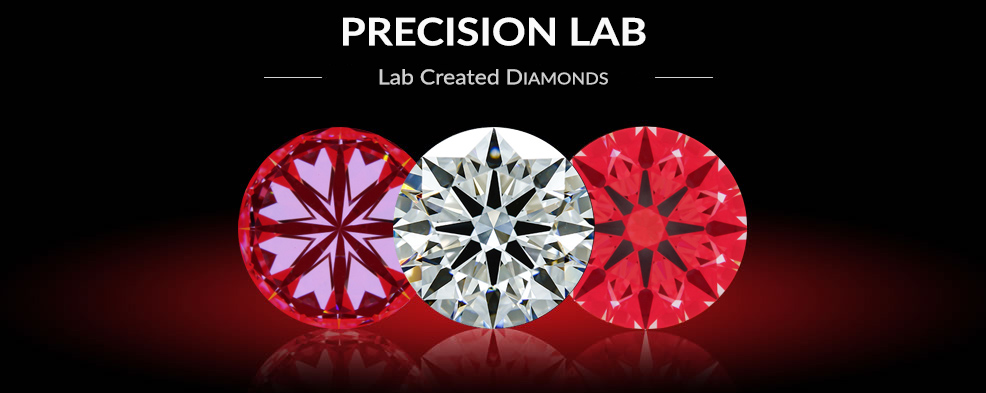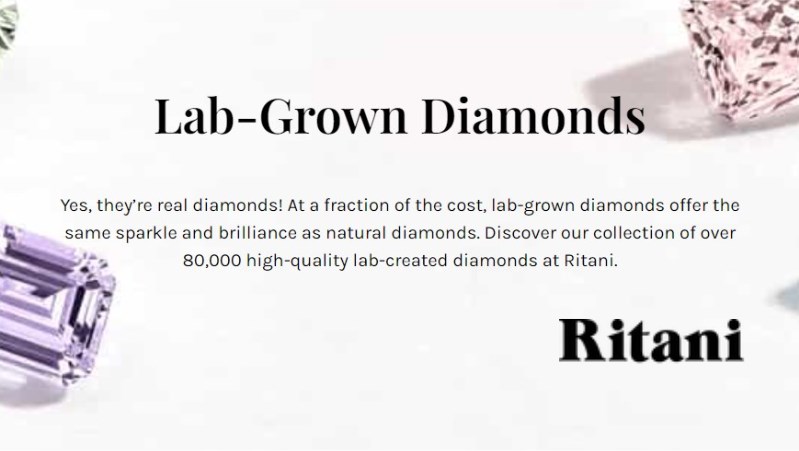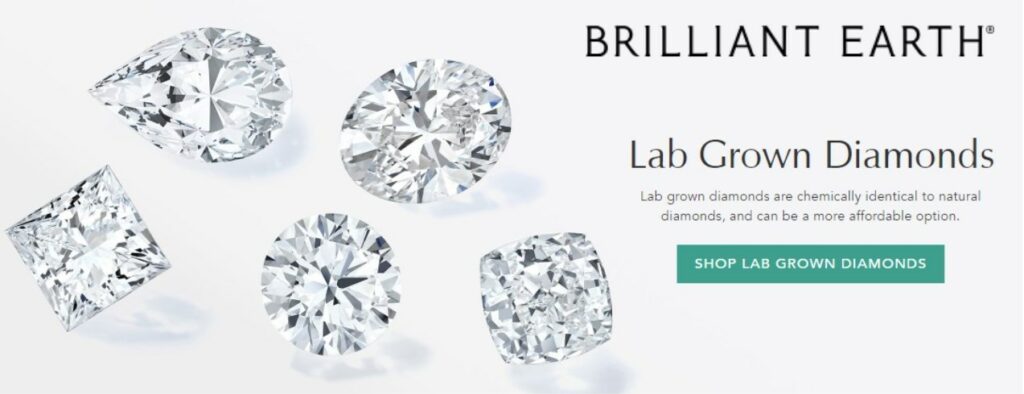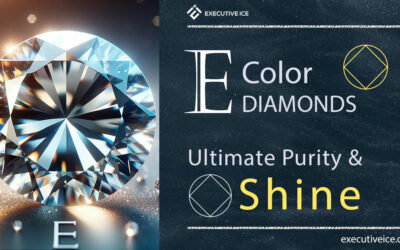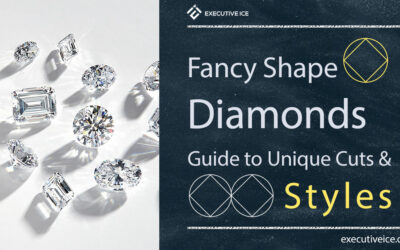Welcome to the ultimate information guide on lab created diamonds.
This guide will cover all you need to understand – from definitions and industrial insights to the creation process, pricing, and the decision on whether you should invest in lab-made diamonds or not.
If you’re searching for the best place to purchase these stones, check out our reviews of the top retailers. If you need a definitive guide on how to buy diamonds, we also have it.
These relatively novel, sparkling gems (commonly referred to as man-made, synthetic, or manufactured diamonds) are steadily gaining popularity.
Therefore, people often want to understand lab-grown diamonds thoroughly before considering a purchase.
Should one think about purchasing engagement rings set with lab-made stones?
Here’s our take on (and the truth about) lab diamonds.
There are numerous misunderstandings surrounding lab-created diamonds. People often get confused because the definition seems somewhat unclear.
With so many different names circulating in the industry, it can be challenging to determine exactly what you’re dealing with.
- Lab-grown diamonds
- Lab diamonds
- Lab-created diamonds
- Synthetic diamonds
- Man-made diamonds
- Cultured diamonds
- Cultivated diamonds
- Manufactured diamonds
- Imitation diamonds
Let’s clarify precisely what we’re discussing.
Are they Real Diamonds?
When introduced to lab-grown stones, the first question most people ask is, “Are lab-created diamonds actual diamonds?”
The answer is, indeed, yes.
However, not all “synthetic” diamonds on the market are genuine lab-made diamonds. So, what does this actually mean?
According to the primary definition of a “synthetic” diamond on Wikipedia, it is “a diamond produced by a controlled process, as contrasted with natural geological processes or an imitation diamond made of non-diamond material…”
Therefore, is a lab-created diamond fake? Not at all.
But some synthetic diamonds, such as cubic zirconias, are not genuine diamonds.
Authentic lab-created diamonds are REAL diamonds. The difference from “natural” diamonds lies in their formation process. And yes, they certainly appear like any standard diamond you see in a jewelry store. It is impossible to distinguish between a natural and a lab-created diamond by just looking at them.
Natural diamonds form under the Earth’s crust through extreme pressure on carbon, while lab-grown diamonds are simply formed in a laboratory under similar conditions, using the same raw materials.
What are NOT Lab-created Diamonds?
To add a bit more complexity, there are different kinds of man-made minerals that you should be familiar with:
Simulant Diamonds
These differ both chemically and physically from natural earth-mined diamonds. They are not made from scratch and include various materials like glass. They first appeared in the 1970s.
Diamond Nexus Simulants
These diamonds are akin to regular simulant diamonds but with carbon mixed into the additional ingredients, making them slightly more durable.
Cubic Zirconia
These are the most affordable “diamond-like” stones available. Made from zirconium dioxide, they are the least durable stone used in jewelry.
These are typically what people refer to as “fake diamonds.”
Moissanite
These popular “fake diamonds” are made from silicon carbide. Due to the gemstone’s durability, it’s a relatively costly option. However, those seeking an authentic diamond look usually do not opt for moissanite, which has a unique appearance.
Here’s a resource we found useful that delves deeper into the differences between diamond and moissanite.
The Real/Cultured Lab-Grown Diamonds
Now, let’s discuss types of lab-grown diamonds that are more “real” when compared to natural earth-mined diamonds.
Cultured stones are made from scratch under conditions similar to those carbon faces in the Earth’s crust. They have a chemical and physical makeup very similar to natural stones.
There are a few types, including High-Pressure, High-Temperature (HPHT) diamonds created using a press, and CVD diamonds created using a method called chemical vapor deposition. The material used for CVD stones is a hydrocarbon gas mixture.
This type of diamond is the most common type of lab-created diamond we see today, which you’ve likely come across on major online stores like James Allen.
Man-Made Diamond Facts
- Not all lab-created diamonds are created equal – simulants like cubic zirconia and moissanite are not real diamonds
- REAL lab-grown diamonds are cultivated from a “diamond seed”
- Diamond seeds undergo intense pressure and heat, simulating the conditions of the Earth’s crust
- Genuine lab-created diamonds share the same chemical and physical properties as natural earth-mined diamonds
- Authentic man-made diamonds are certified by major certification labs (GIA, AGS, IGI), just like natural diamonds
- Lab diamonds are always of the highest purity
- Both natural diamonds and lab-created stones are measured in Carats
History of Lab-Grown Diamonds
Synthetic diamonds, though gaining recent popularity, have a history that dates back to the mid-20th century. The first lab-grown diamonds were created in the 1950s, primarily for industrial use due to their desirable properties such as extreme hardness and heat conductivity. Consumer-focused lab diamonds didn’t become a reality until much later.
The first successful synthesis of diamonds was reported by General Electric in 1955, though it’s believed that a Swedish company had achieved this feat two years earlier. These diamonds, however, were not meant for consumer markets but were used for industrial purposes.
Synthetic gemstones made their way to the consumer market in the 1970s and 1980s, but the quality of these early creations was not on par with today’s lab-grown diamonds. Over the last four decades, advancements in technology have resulted in lab-grown diamonds that rival, and in some cases surpass, the quality of natural diamonds.
How do Labs Grow or Create Precious Gem Stones?
So how are lab created diamonds made, exactly?
We know that in natural diamonds, they are put under are prolonged over billions of years. Geologists believe 1-3 billion years ago carbon dioxide trapped 100 miles underneath the earth’s crust was exposed to temperatures of 2200 degrees Fahrenheit.
Add to that pressure equal to 727,000 pounds per square inch, followed by violent volcanic explosions, and voila – you’ve got diamonds.
Lab-grown diamonds are created by simulating the conditions under which natural diamonds form in the Earth’s crust. Using a ‘diamond seed’, extreme heat and pressure are applied to replicate the natural diamond formation process.
There are different methods to create these diamonds, including High Pressure, High Temperature (HPHT) and Chemical Vapor Deposition (CVD). These methods can produce diamonds that are chemically, physically, and optically identical to natural diamonds.
How Long does it Take to Make a Lab-Created Diamond?
It’s not as fast as you’d hope, but it’s better than waiting a few billion years.
In general, it can take anywhere from 4 to 12 weeks to form a man made diamond using the processes described above.
Are Lab Diamonds Ethical?
Lab-grown diamonds indeed provide a more ethical alternative to their naturally occurring counterparts. The diamond mining industry is fraught with ethical dilemmas, ranging from the use of child labor to conflict financing. Even diamonds that are certified conflict-free still pose issues, such as a high rate of serious injuries among workers.
Lab-grown diamonds, on the other hand, are produced in controlled environments where such problems are virtually nonexistent. As a result, they offer a more humane and ethical way to enjoy the beauty and brilliance of diamonds without contributing to human rights abuses and conflicts.
Moreover, lab-grown diamonds also have a much lesser environmental footprint. In contrast to natural diamond mining, which disrupts large areas of land and generates significant amounts of waste, the production of lab-grown diamonds is much more sustainable.
Therefore, for those conscious about the impact of their consumption habits on the environment, choosing lab-grown diamonds is an excellent choice.
Do Lab Made Diamonds Come in High Qualities?
There’s a common misconception that lab-grown diamonds are inferior to natural diamonds in terms of quality.
This confusion often stems from the fact that people conflate lab-grown diamonds with diamond simulants, such as cubic zirconia or moissanite, let’s break this down…
Quality
Ever wondered if these lustrous, lab-grown beauties match up to their natural cousins in quality?
We are here to set the record straight once and for all – YES!
These are top-notch, unadulterated carbon marvels! Initially, these synthetic stunners had their share of flaws and blemishes, but thanks to technological advancements, they now shine with unmatched brilliance and clarity.
What we have today are exquisite, flawless gem-quality stones – lab-crafted diamonds as real as any natural ones.
Durability
If the durability of lab-grown diamonds is causing you to break a sweat, allow us to alleviate your concerns.
Engineered to perfection, these stones hold their own against any earth-mined variants. Not only do they refrain from cracking under pressure, but their scratch-proof surface is also a bonus.
Wondering about the lifespan of these diamonds? They’re designed to last a lifetime!
As for their hardness, it stands tall at 10 on the MOHS scale. That’s the same as natural diamonds and way above everyday materials!
Clarity
Lab-grown diamonds are examined under the same rigorous standards as natural ones to determine their clarity.
The scale identifies any inclusions or blemishes that may affect their appearance. Yes, it’s true – lab-grown diamonds may carry inclusions.
However, top-tier retailers, such as James Allen, assure an SI1 clarity grade for most of their inventory. This means the diamonds will be perfectly clear to the naked eye in most cases.
Rest assured, factors like diamond fluorescence and fogging are kept under strict control, promising a consistently captivating sparkle.
Color
As we journey down the diamond color scale from D (colorless) to Z (yellow) based on GIA certification, lab-grown diamonds mostly reside at the higher end, closer to colorless group (D-F),so you likely won’t find yellow man made diamonds.
High color ratings can often compromise the diamond’s sparkle, but with lab-created diamonds, there’s little to worry about. They are designed to optimize refraction and keep the mesmerizing sparkle intact.
James Allen has lab made diamonds ranging from D to H.
Cut and Carat Weight
Since lab-grown diamonds are handcrafted, their cut and carat weight are tailored to meet popular demand.
You’ll find ideal cuts and larger carat weights as the norm among reputable lab diamond retailers.
Look at James Allen, for example – you’ll see a range of high-grade cuts and a diverse range of weights, from 0.3 to a whopping 17 carat lab-created diamond!
Yes, the price tag grows with the weight, but the beauty of lab-grown diamonds is that you’ll always find exactly what your heart desires.
Lab-Created Diamonds Pros and Cons
When the glitter of diamonds catch your eye, it’s easy to be swept away into the allure of their natural charm, bypassing the option of their lab-grown alternatives.
The diamond industry, predominantly steered by De Beers, has done a fantastic job of cementing the reputation of natural diamonds as the ultimate symbol of rarity and value.
However, depending on your circumstances, lab-grown diamonds could be a stellar choice.
Let’s delve into the benefits and downsides of choosing these man-made wonders over their earth-mined relatives:
Pros
- More bang for your buck: Enjoy a larger, sparklier rock for a significantly lower price tag. We’re talking about savings of over 30% compared to their earth-born counterparts
- Ethically sourced, guilt-free sparkle: Wave goodbye to nightmares of conflict diamonds, and rest easy knowing your stone hasn’t been tainted by war or child labor
- Green bling: As these diamonds are crafted in labs, they sidestep the environmentally destructive mining process, making them a friendlier choice for Mother Earth
- Aesthetic perfection: These gems are engineered for optimum beauty and sparkle. With natural diamonds, the results depend on geological potluck
- Indistinguishable allure: Put a lab-grown and natural diamond side by side, and even the most discerning eyes would struggle to tell them apart
Cons
- Common sparkle: As lab-grown diamonds are crafted rather than mined, they can’t claim the rarity of their natural counterparts
- Lacks natural charm feeling: Despite being physically and chemically identical, lab-grown diamonds miss out on the enchanting allure of being a product of Mother Nature’s grandeur
- A depreciating asset: Just like their natural siblings, lab-grown diamonds aren’t a sound investment. Their resale value plummets over time, making them a poor choice for those seeking a long-term asset, akin to gold
Lab Diamonds vs. Other Gem Stones
Are lab created diamonds real diamonds? Of course, they are.
There are many differences between these stones and other types of simulant diamonds, we’ve gone over many of the differences between lab created diamonds vs natural earth mined diamonds.
In this section we’ll go over the differences between synthetic diamonds that are man-made and diamond simulants than are not real diamonds.
Lab Diamonds vs. Moissanite
At a basic level, moissanite vs lab diamonds is clear – moissanite is not a diamond.
Diamonds, even lab grown ones, are made of pure carbon. Moissanite is made from silicone carbide, but that doesn’t mean moissanite is not valuable. In fact, moissanite is an extremely rare natural earth mineral. It’s not manufactured at all.
On the flip side, moissanite is not as hard as lab or earth diamonds. Moissanite is rated on the MOHS hardness scale at 9.25 whereas diamonds are at 10.
On the refractive index, diamonds rate 2.42 whereas moissanite is around 2.65.
Lab Diamonds vs. Cubic Zirconia
It’s important to remember that lab created diamonds are not the same thing as cubic zirconia’s.
Cubic zirconia is made with a mineral called zirconium dioxide and the final stone has a hardness level of 8.25 (again, diamonds are 10).
When people often speak of “fake diamonds” they’re usually talking about CZs, which were popularized in the consumer market by Swarovski & Pandora.
In terms of the refractive index, CZs rate at 2.2, whereas diamonds rate 2.42.
Cubic zirconia’s have a completely different chemical composition and physical properties to natural and lab grown diamonds.
When placed side by side, diamonds refract light in a clean way whereas CZs will have a “rainbow effect.”
Diamond Certification: How Lab Diamonds Grading Works?
Just like their earth-mined counterparts, lab-grown diamonds are put through rigorous grading processes. They are measured against the same 4Cs (Carat, Cut, Clarity, Color) that govern the grading of natural diamonds.
Among the most trusted grading entities is the Gemological Institute of America (GIA), with other reputable institutes like IGI also playing a part.
These institutes have a team of experienced gemologists who meticulously examine each diamond to determine its appropriate grade. This final grade is then handed over to retailers and customers.
However, it’s crucial to bear in mind that grading is somewhat subjective. Different labs might assign different grades to the same diamond, owing to the specific standards they follow and the tools they employ. But fear not, each lab employs highly skilled gemologists who know their craft inside out. When grading entities like GIA, AGS, or IGI are involved, you can rest assured that the grading process is reliable and trustworthy.
Facts About Lab-Grown Diamonds Grading
Each lab might use different methods and machines but here’s what they all agree on:
- All colorless diamonds are initially screened to determine if they are type Ia, which makes up around 98% of all natural white diamonds.
- Diamonds identified as type II are subjected to additional testing.
- Screening methods used include infrared (IR) spectroscopy, ultraviolet (UV) absorption, UV transparency, and photoluminescence (PL) imaging.
- These machines can accurately identify natural diamonds with about a 97% success rate.
- Around 3% of natural diamonds are marked for further testing.
- Type Ib diamonds, which are deep yellow and brown, usually proceed directly to the finalizing processes.
- Diamonds that have been flagged for additional testing undergo a finalizing process. This involves manual examination using machines that analyze element composition, crystal structures, electromagnetic absorption, phosphorescence, and fluorescence, among other things.
- IR spectroscopy involves measuring how various elements in a diamond absorb electromagnetic radiation at different wavelengths. Each type of diamond absorbs infrared light at specific wavelengths.
- UV absorption is similar to IR spectroscopy in that it measures whether diamonds absorb UV rays at the wavelength that type I diamonds do.
- The UV transparency method checks whether certain bands of light can pass through a diamond. Type Ia natural diamonds, which are opaque to this light, are differentiated from type IIa diamonds, which appear colorless and are transparent to this light.
- PL imaging tests for fluorescence, or how a diamond glows under UV light, as well as the strength and duration of phosphorescence, which is a diamond’s ability to continue glowing after the UV source has been turned off. Natural type Ia diamonds typically fluoresce blue and do not phosphoresce. Any diamond that glows in other colors or continues to glow is sent for additional testing.
Source: Rapaport
Lab Grown Diamond Prices
Lab-grown diamonds are making a significant splash in the market, and their attractive pricing plays a considerable role in this. These lab-engineered marvels often come with a much lighter price tag compared to natural diamonds.
In fact, you could find the exact same gem, lab-created, costing up to 30-40% less than its natural counterpart.
This price disparity largely stems from the differences in their supply chains. A natural diamond travels through several stages (and hands) before it finally dazzles in a jewelry store – each stage adding to its cost. On the other hand, lab-grown diamonds follow a much shorter route, which is reflected in their price.
To illustrate, when De Beers initially ventured into the lab-diamond market, a $6000 natural diamond could be replicated in a lab for $4200. Later, De Beers began retailing lab-grown diamonds for $800 per carat.
While this might still seem expensive, remember, these are genuine diamonds – just man-made. Synthetic alternatives like cubic zirconia may come cheaper, but they don’t quite match up.
Lab-grown diamonds are the real deal – pure carbon crystals formed under intense heat and pressure. Plus, they come with the added benefit of near-perfect quality.
Looking at Overall Value for Lab-Grown Diamonds
A commonly pondered question among prospective diamond buyers is whether these man-made gems retain their value over time. Sadly, the truth is that the resale value of lab-created diamonds tends to decline.
In 2017, the cost of lab-made diamonds was marginally higher than that of their natural counterparts, primarily due to supply-demand dynamics and the state of technology at the time. However, a glance at the current prices reveals a significant drop, rendering them much more affordable.
The valuation of natural diamonds differs from lab-created ones due to the inherent scarcity of natural gems. The quantity of natural diamonds on our planet is limited, and this number is unlikely to see any dramatic change (at least as far as we’ve been informed, given that a few dominant players control the market supply).
On the other hand, lab-created diamonds aren’t as rare, and there’s no apparent threat to their supply. In fact, we may witness even more sophisticated manufacturing processes and further price reductions in the near future.
So, do lab-created diamonds retain their value?
The simple answer is no. Attempting to sell your lab-made jewelry on platforms like eBay will fetch you only a fraction of your initial investment. And seeking a buy-back from a jeweler might not be worth the effort.
However, this doesn’t necessarily pose a problem for most diamond jewelry shoppers. A purchase such as a diamond engagement ring is made with sentiment, not resale, in mind.
Therefore, if your objective isn’t to make a profit or preserve capital, you might find yourself more satisfied purchasing diamonds, be they lab-created or natural, due to the numerous advantages they offer.
Can you Tell if a Diamond is Lab-Grown?
They look like natural diamonds, they shine like natural diamonds, but if you always refer to diamonds as being natural ones, then they are not diamonds – at least not in the true sense of the word.
Can you tell the difference?
Here are some hints we can think of to help you distinguish a lab-grown diamonds from natural ones.
1. Graining patterns: One of the primary ways to distinguish between lab-grown and natural diamonds is to look at their graining patterns. Lab-grown diamonds often have a unique and distinctive pattern of graining that doesn’t typically occur in natural diamonds.
2. Growth structures: Lab-grown diamonds have different growth structures than natural diamonds, due to the differences in the conditions under which they form. These differences can be picked up under a microscope or other imaging techniques by trained gemologists.
3. Inclusions: Inclusions are small imperfections or internal characteristics that occur within a diamond. Lab-grown diamonds often have inclusions that are characteristic of the high-pressure, high-temperature (HPHT) or chemical vapor deposition (CVD) methods used to create them. These can include metallic inclusions or specific growth lines not found in natural diamonds.
4. Fluorescence: Under ultraviolet light, some lab-grown diamonds may exhibit strong fluorescence or phosphorescence, while natural diamonds typically have weaker fluorescence or none at all. However, this is not a foolproof method as some natural diamonds also have strong fluorescence.
5. Spectroscopic analysis: Advanced tools like spectrometers can be used to analyze a diamond’s light absorption and emission characteristics. These can help identify specific atomic and sub-atomic structures that are unique to lab-grown diamonds.
So, while you as a customer or even a jeweler may not be able to tell the difference between a lab-grown diamond and a natural diamond, a trained gemologist using the right tools and techniques can.
That’s why it’s critical to only buy diamonds (either natural or lab-grown) that come with a certificate from a reputable gemological laboratory such as GIA (Gemological Institute of America) or AGL (American Gemological Laboratories). The certificate verifies the origin, quality, and characteristics of the diamond.
Where to Buy Lab-Grown Diamonds?
1. James Allen
When we keep referencing James Allen, it isn’t just because we have a fondness for them. They are, after all, an online platform offering a staggering half a million diamonds, each with its own 360-degree HD image and magnification of up to 40 times! Add to that, their prices are impressively competitive.
As one of the world’s premier retailers of lab-created diamonds, James Allen has a staggering 54,000+ lab-grown diamonds in its collection. They offer an array of brilliant diamonds varying in size from 0.3 to over 15 carats.
2. Blue Nile
Blue Nile is another significant player in the online diamond market, similar to James Allen. Despite their initial reluctance to offer lab-created diamonds, they eventually expanded their product line to meet market demand.
Now, Blue Nile presents a wide array of high-quality lab-grown diamonds in response to the increasing consumer demand for affordable and ethically sourced diamonds. Presently, their inventory features over 12,500 lab-created diamonds, with prices ranging from a humble $300 to a whopping $52,000 for an 8+ carat diamond.
3. Whiteflash
Whiteflash, famous for its A CUT ABOVE® collection of super ideal Heart & Arrows diamonds, has tactically ventured into the world of lab-grown diamonds.
Even though Whiteflash had previously been committed solely to premium cut diamonds, they adapted to the rapid market shift towards lab-grown diamonds. In keeping with their reputation for quality, they offer only premium cut lab-created diamonds.
Accompanied by grading reports from the International Gemological Institute (IGI), Whiteflash assures that their lab-grown diamonds are “As Grown” with no post-growth treatments. With over 1300 lab-created diamonds in their inventory, Whiteflash has made a robust entry into this growing market.
4. Ritani
Ritani, established in 1999, predates most other brands in the online diamond and jewelry market. Renowned for its high-quality offerings, Ritani boasts a remarkable collection of 80k+ lab-grown diamonds.
With their dedication to offering ethically sourced and environmentally friendly alternatives to mined diamonds, they provide a broad range of cuts, colors, and sizes.
Ritani ensures customers can find a lab-grown diamond that fits their preferences and values, making them a trusted source for these sustainable gems.
5. Brilliant Earth
Brilliant Earth stands out as an innovator in the jewelry industry, with a steadfast commitment to environmental sustainability. They offer a wide selection of lab-grown diamonds, providing customers with eco-friendly and ethical alternatives to mined diamonds.
Known for their transparency and ethical business practices, Brilliant Earth has established itself as a preferred retailer for high-quality lab-created diamonds.
They currently have an astonishing collection of over 228,000 lab-created diamonds on their website, catering to a range of budgets.
Final Thoughts
There you have it – the ultimate guide on lab created diamonds. On this page we covered everything you need to know about lab diamonds if you’re just getting started in the industry.
There is much more depth and detail that could be gone into, but for our purposes we’ve already covered quite a bit of information.
If you’re interested in buying high quality lab created diamonds that are near perfect, our top pick is James Allen – they are the best supplier online for both natural, earth-mined diamonds and high quality pure-carbon lab grown diamonds.

